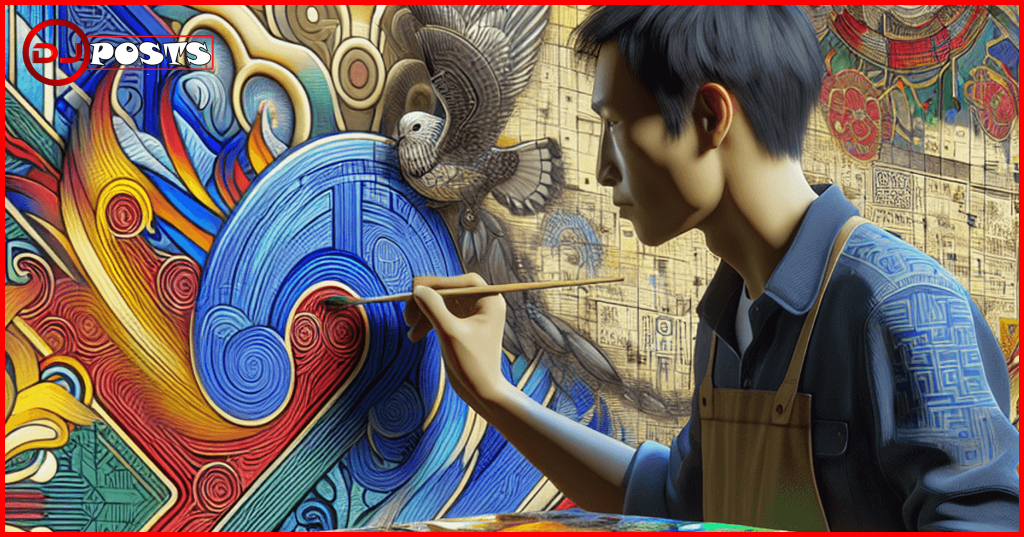Welcome to the ultimate guide for Modern Lippan Art in 2024! If you’ve ever been captivated by the intricate mud and mirror work that adorns homes and public spaces in Kutch, Gujarat, you’re in for a treat. This guide dives deep into the fascinating world of modern Lippan art, shedding light on its origins, evolution, and contemporary significance.
Traditional crafts like Lippan art hold a special place in today’s fast-paced world. They connect us to our roots and offer a tactile experience that digital art simply can’t replicate. The timeless beauty of Lippan art lies not just in its aesthetic appeal but also in its cultural richness and the stories it tells.

Key Takeaways from the Guide:
- Understanding Lippan Art: Learn about its origins in Kutch, traditional techniques, and cultural significance.
- Evolution: Explore how contemporary artists are redefining this ancient craft using modern materials and designs.
- Techniques: Discover the step-by-step process of creating Lippan art, focusing on unique methods like mud and mirror work.
- Significance Today: Delve into how Lippan Kaam promotes cultural heritage and empowers artisans economically.
- Modern Applications: See how this traditional art form is being used in contemporary home decor and brand collaborations.
- Buying Guide: Find out where to purchase authentic Modern Lippan Art both online and offline.
- Community Engagement: Learn about educational initiatives preserving this craft form.
Understanding Lippan Art
Lippan art is a captivating traditional Indian craft that originates from the Kutch region of Gujarat. This art form is known for its intricate designs that bring walls to life using clay and mirrors.
Origins of Lippan Art in Kutch, Gujarat
Lippan art, also referred to as Lippan Kaam, emerged from the barren yet culturally rich lands of Kutch. The Rabari community, a nomadic tribe, is credited with pioneering this unique craft. Historically, their mud huts or bhungas would be adorned with these beautiful designs, making their homes not just shelters but canvases of artistic expression.
Traditional Techniques and Materials Used in Lippan Art
Creating a piece of traditional Lippan art involves:
- Clay: Sourced locally, the mud is mixed with camel dung to get the perfect consistency.
- Mirrors: These tiny reflective pieces are meticulously embedded into the wet clay.
- Tools: Simple tools like sticks and fingers are used to shape and carve designs.
The process begins by applying a base layer of clay on the wall. While the clay is still damp, artisans press mirrors into it to form patterns that range from geometric shapes to floral motifs. The design is then left to dry and harden naturally under the sun.
Cultural Significance of Lippan Art in the Rabari Community
For the Rabari people, Lippan art goes beyond mere decoration. It serves as:
- Aesthetic Enhancement: The reflective mirrors catch light beautifully, illuminating their humble abodes.
- Cultural Identity: Each design tells a story or holds symbolic meaning related to their traditions and beliefs.
- Social Bonding: Creating these artworks often becomes a communal activity where members come together, fostering unity and preserving their heritage.
In essence, Lippan art is not just an artistic endeavor but a vibrant testament to the Rabari community’s way of life, blending functionality with beauty in every stroke and mirror.
The Evolution of Modern Lippan Art
Modern Lippan art, often referred to as contemporary mud mirror art, has come a long way from its traditional roots in the Kutch region of Gujarat. As society evolves, so does art, and Lippan Kaam is no exception.
From Traditional to Modern Interpretations
Traditional Lippan art, which was mainly found on the walls of rural homes featuring intricate clay and mirror designs inspired by nature and everyday life, is now evolving. This traditional art was deeply rooted in the cultural heritage of the region. However, as cities grew and artists wanted to preserve this heritage while appealing to modern tastes, the shift towards contemporary interpretations began.
The Role of Contemporary Artists
Contemporary artists play a crucial role in redefining Lippan Kaam. They experiment with styles, themes, and techniques that resonate with today’s audience. By doing so, they ensure that this age-old craft remains relevant. For example:
- Geometric Patterns: Modern artists often use geometric patterns instead of traditional floral and animal motifs.
- Abstract Designs: Incorporation of abstract elements adds a modern touch to the artwork.
Incorporating New Materials and Designs
Another significant evolution is the incorporation of new materials alongside traditional clay and mirrors. Artists now use:
- Acrylic Mirrors: These are lighter and more versatile compared to traditional glass mirrors.
- Paints and Pigments: Adding colors enhances the vibrancy of the pieces.
- Wooden Bases: Instead of creating murals directly on walls, wooden panels are used for portability.
These innovations have expanded the application scope of Lippan art from wall murals to standalone decorative pieces like frames, coasters, and even furniture.
By embracing these changes, modern Lippan art breathes new life into a time-honored tradition. It bridges the gap between past and present, allowing both the creators and admirers to celebrate cultural heritage in a contemporary setting.
This adaptability ensures that this craft holds its place both historically and aesthetically in today’s world.
Techniques Used in Modern Lippan Art
Creating a piece of Lippan art is an intricate process that requires patience and skill. Here’s a step-by-step guide to understanding the technique of Lippan art:
Step-by-Step Process
1. Preparing the Base
Start with a smooth surface, usually a wooden board or canvas. This base is essential for applying the clay mixture.
2. Mixing the Clay
Combine clay with water to achieve a dough-like consistency. Some artists add camel dung for traditional authenticity and strength, though it’s optional in modern interpretations.
3. Applying the Clay
Roll the clay into thin, snake-like rolls and apply them onto the base to form intricate designs. This stage demands precision and creativity as it lays the foundation for your artwork.
4. Embedding Mirrors
While the clay is still wet, press small mirror pieces into the design. This step is crucial for creating the signature mud-reflect work that Lippan art is known for.
5. Drying and Finishing
Allow the piece to dry completely, which can take several days depending on weather conditions. Once dry, you can paint or leave it natural, depending on your desired aesthetic.
Unique Techniques
The hallmark of Lippan art lies in its unique techniques:
- Mud and Mirror Work: The combination of clay (mud) and mirrors creates a stunning visual effect that reflects light beautifully. This technique adds depth and dimension to the artwork.
- Handmade Craftsmanship: Every piece is crafted by hand, ensuring each one is unique. The tactile nature of working with clay allows artisans to infuse their personality and style into each creation.

Importance of Handmade Craftsmanship
Handmade craftsmanship holds immense value in modern Lippan art:
- Authenticity: Handcrafted pieces retain cultural authenticity and connect us to ancient traditions.
- Economic Support: Purchasing handmade Lippan art supports local artisans, providing them with economic empowerment.
- Sustainability: Handmade processes often use locally sourced materials and sustainable practices, making them environmentally friendly.
The latest info on Modern Lippan art reveals how contemporary artists are blending these traditional techniques with new materials like acrylics and resin, pushing boundaries while maintaining the essence of this beautiful craft form.
This combination of tradition and innovation keeps Lippan art relevant in today’s world, offering endless possibilities for creativity and expression.
The Significance of Lippan Kaam Today
Lippan Kaam, or Lippan art, has always held a special place in the cultural fabric of Gujarat. But what does it mean for us today? Let’s explore its significance in our modern world.
Promoting Cultural Heritage
Lippan art isn’t just about aesthetics; it’s a vibrant expression of cultural heritage. Each piece tells a story, reflecting the traditions and lifestyle of the Rabari community. By integrating Lippan art into modern spaces, we celebrate and preserve these rich histories. It’s a living tradition that connects us to the past while adding depth to contemporary designs.
Economic Empowerment for Artisans
Lippan Kaam plays a crucial role in providing economic opportunities for artisans, especially women. Many organizations support these artisans by offering platforms to sell their creations. These initiatives empower local communities, enabling them to sustain their craft and livelihood.
“Artisans find dignity and financial independence through their craft, transforming mud and mirrors into durable wall hangings that captivate modern audiences.”
Impactful Community Workshops
Community workshops are pivotal in keeping the spirit of Lippan art alive. These events offer hands-on experience, inviting people from all walks of life to engage with the craft. Workshops not only spread awareness but also foster appreciation for traditional skills, ensuring that Lippan Kaam continues to thrive.
Educational Programs
Schools and cultural institutions incorporate Lippan art into their curriculums, teaching younger generations the value of traditional craftsmanship.
Public Exhibitions
Art fairs and exhibitions showcase Lippan works, providing artisans with wider recognition and preserving this unique art form for future generations.
By supporting these initiatives, we contribute to sustaining a beautiful tradition that enriches our cultural landscape.
Exploring Modern Applications and Collaborations with Brands like MeMeraki
Modern Lippan art has found a place in contemporary home decor, transforming traditional patterns into chic and stylish pieces. These artworks are now used to adorn living rooms, bedrooms, and even office spaces, adding a touch of ethnic charm and elegance.
Use of Lippan Art in Contemporary Home Decor
Decorative patterns in modern Lippan art have evolved to suit varied tastes. You might find intricate designs featuring geometric shapes or floral motifs that seamlessly blend with modern interiors. Custom Lippan pieces are becoming increasingly popular for those looking to add a personalized touch to their homes.
Examples of Modern Installations Using This Technique
Some stunning examples include:
- Wall Panels: Large panels adorned with mud and mirror work create striking focal points in any room.
- Furniture Accents: Incorporating Lippan art into furniture pieces like coffee tables and headboards adds an artistic flair.
- Mirror Frames: Reflective surfaces combined with traditional designs make for captivating mirror frames that double as decor.
Collaborations with Brands to Create Unique Pieces
Brands like MeMeraki are at the forefront of bringing this traditional craft into the limelight. By collaborating with local artisans, they create unique pieces that marry old-world charm with modern aesthetics. These collaborations don’t just produce beautiful items but also help preserve the craft by providing artisans with a platform to showcase their skills.
MeMeraki’s collections often feature limited-edition items that reflect both the brand’s vision and the artisan’s creativity. Such initiatives highlight how traditional crafts can be adapted for contemporary settings while ensuring that the heritage and techniques remain intact.
By bringing Lippan art into the mainstream, these brands play a pivotal role in keeping this cultural treasure alive and relevant.
Where to Buy Authentic Modern Lippan Art Pieces Online and Offline Markets like Artociti
If you’re looking to add the beauty of Lippan art to your home, finding genuine pieces can be an exciting adventure. With the growth of online shopping and curated marketplaces, there are many places where you can find authentic Lippan art made by skilled craftsmen.
Recommended Online Platforms
Here are some recommended online platforms where you can find authentic modern Lippan art pieces:
- Artociti: One of the top places to buy genuine Lippan art. They have a wide selection of pieces made by talented artists from Gujarat, ensuring high quality and authenticity.
- Etsy: Known for its wide variety of handmade items, Etsy has several shops that specialize in both traditional and modern Lippan art. Look for sellers with good reviews and detailed descriptions of their work.
- MeMeraki: This platform works with local artisans to combine traditional craftsmanship with modern designs. Their collection often includes one-of-a-kind Lippan art pieces that stand out in contemporary home decor.
- Tisser: An organization that supports cultural crafts by connecting artisans directly with buyers. They offer a range of Lippan art, focusing on fair trade and empowering artisans.
Tips for Buying from Local Markets
Shopping for Lippan art in local markets can be a rewarding experience. Here are some tips to help you find the best pieces:
- Visit Artisan Hubs: Places like Bhuj in Kutch are famous for their traditional crafts, including Lippan. Going to these areas gives you the chance to meet artisans in person and learn more about their work.
- Check Craft Fairs and Exhibitions: Many cities hold events showcasing regional crafts. These fairs give you the opportunity to see a wide variety of Lippan art and buy directly from the artists.
- Ask for Authentication: When purchasing expensive pieces, ask for certificates or documents that prove the artwork’s origin and craftsmanship.
- Inspect Craftsmanship: Take a close look at the details. Genuine Lippan art will have fine workmanship, intricate mirror placements, and smooth clay finishes.
By exploring both online platforms and local markets, you can discover beautiful Lippan art pieces that not only enhance your home but also support the rich tradition and talented craftsmen behind this stunning craft.
Community Engagement and Education Initiatives for Preserving Modern Lippan Art
Education plays a key role in sustaining the rich heritage of Modern Lippan Art. Learning about modern Lippan art not only helps preserve this traditional craft but also ensures it evolves with contemporary influences. Various initiatives are being undertaken to educate both artisans and enthusiasts.
Importance of Education in Sustaining This Craft Form
1. Workshops and Classes
Regular workshops are organized, providing hands-on experience in creating Lippan art. These sessions often involve local artisans sharing their expertise, ensuring traditional techniques are passed down to new generations.
2. School Programs
Integrating Lippan art into school curriculums encourages young minds to appreciate and engage with this craft form from an early age. This approach aligns with the importance of incorporating local culture into community development, fostering a deeper understanding and respect for the art form.
3. Online Tutorials
Many platforms offer online tutorials and courses, making it accessible for people worldwide to learn about modern Lippan art.
Events Showcasing the Beauty of Modern Lippan Art Across India
1. Exhibitions
Cities across India frequently host exhibitions that display both traditional and modern interpretations of Lippan art. These events attract art lovers and provide a platform for artisans to showcase their work.
2. Cultural Festivals
Festivals often include segments dedicated to folk arts like Lippan Kaam. These vibrant celebrations highlight the cultural significance and beauty of the craft.
3. Community Projects
Collaborative projects involving local communities help create public installations that are not only visually stunning but also educational. Such projects foster a sense of pride and ownership among community members, reinforcing the idea that cultural diversity in the classroom can lead to richer learning experiences.
Engagement through education and community events ensures that Modern Lippan Art remains a living tradition, continually inspiring new artists and admirers alike.
Conclusion: Embracing the Future of Modern Lippan Art and Supporting Local Artisans
Lippan art has come a long way from its traditional roots in Kutch. The future of modern Lippan art looks bright as contemporary artists continue to innovate while staying true to its cultural essence. This evolving landscape is rich with possibilities, combining time-honored techniques with fresh, modern aesthetics.
Exploring and supporting modern artists is essential. By purchasing authentic pieces, attending workshops, or simply spreading the word, you contribute to the preservation and growth of this beautiful craft form.
“Art is not what you see, but what you make others see.” – Edgar Degas
Stay connected with the latest updates on Modern Lippan art and become a part of this vibrant community that cherishes and uplifts local artisans.
FAQs (Frequently Asked Questions)
What is Modern Lippan Art?
Modern Lippan Art is a contemporary interpretation of traditional Lippan art, which originates from Kutch, Gujarat. It features intricate designs and uses materials like clay and mirrors to create decorative pieces that reflect both cultural heritage and modern aesthetics.
What are the traditional techniques used in Lippan Art?
Traditional techniques in Lippan Art involve the use of mud-reflect work, where artisans apply clay and mirror pieces to create beautiful patterns. This craft has deep cultural significance, especially within the Rabari community.
How has Lippan Art evolved over time?
Lippan Art has evolved from its traditional roots to incorporate contemporary designs and materials. Modern artists are redefining this craft by adding new elements while maintaining its intrinsic cultural values.
What is the significance of Lippan Kaam today?
Lippan Kaam plays a crucial role in promoting cultural heritage and provides economic empowerment for artisans. It also fosters community engagement through workshops that educate others about this unique craft.
Where can I buy authentic Modern Lippan Art pieces?
You can find authentic Modern Lippan Art pieces both online and offline. Recommended online platforms include various art marketplaces, while local markets such as Artociti offer opportunities to purchase directly from artisans.
What initiatives are in place for preserving Modern Lippan Art?
Community engagement and education initiatives are vital for preserving Modern Lippan Art. Events showcasing this craft across India help raise awareness and appreciation, ensuring that it continues to thrive in the future.



[…] Modern Lippan Art: The Ultimate Guide for 2024 […]